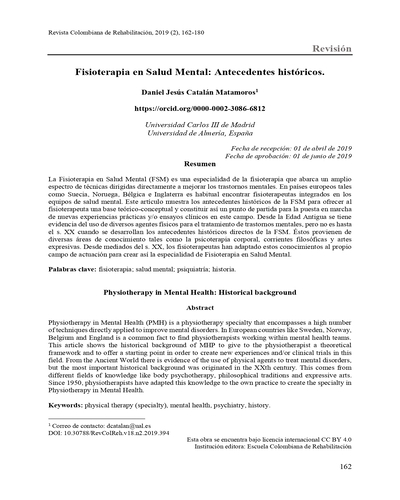Fisioterapia en salud mental: antecedentes históricos.
Contenido principal del artículo
Autores
Daniel Jesús Catalán Matamorosdcatalan@ual.es
Resumen
La Fisioterapia en Salud Mental (FSM) es una especialidad de la fisioterapia que abarca un amplio espectro de técnicas dirigidas directamente a mejorar los trastornos mentales. En países europeos tales como Suecia, Noruega, Bélgica e Inglaterra es habitual encontrar fisioterapeutas integrados en los equipos de salud mental. Este artículo muestra los antecedentes históricos de la FSM para ofrecer al fisioterapeuta una base teórico-conceptual y constituir así un punto de partida para la puesta en marcha de nuevas experiencias prácticas y/o ensayos clínicos en este campo. Desde la Edad Antigua se tiene evidencia del uso de diversos agentes físicos para el tratamiento de trastornos mentales, pero no es hasta el s. XX cuando se desarrollan los antecedentes históricos directos de la FSM. Éstos provienen de diversas áreas de conocimiento tales como la psicoterapia corporal, corrientes filosóficas y artes expresivas. Desde mediados del s. XX, los fisioterapeutas han adaptado estos conocimientos al propio campo de actuación para crear así la especialidad de Fisioterapia en Salud Mental.
Palabras clave:
Detalles del artículo
Licencia
Aquellos autores/as que tengan publicaciones con esta revista, aceptan los términos siguientes:
- Los autores/as conservarán sus derechos de autor y garantizarán a la revista el derecho de primera publicación de su obra, el cuál estará simultáneamente sujeto a la Licencia de reconocimiento de Creative Commons que permite a terceros compartir la obra siempre que se indique su autor y su primera publicación esta revista.
- Los autores/as podrán adoptar otros acuerdos de licencia no exclusiva de distribución de la versión de la obra publicada (p. ej.: depositarla en un archivo telemático institucional o publicarla en un volumen monográfico) siempre que se indique la publicación inicial en esta revista.
- Se permite y recomienda a los autores/as difundir su obra a través de Internet (p. ej.: en archivos telemáticos institucionales o en su página web) antes y durante el proceso de envío, lo cual puede producir intercambios interesantes y aumentar las citas de la obra publicada. (Véase El efecto del acceso abierto).
Los autores que publican en la revista se acogen al código de licencia de Creative Commons Atribución 4.0 Internacional (CC BY 4.0)




Referencias
Alexander, F. (1987).The use of the self. Nueva York, Estados Unidos: Dutton.
Baril, J. (1987). La danza moderna. Barcelona, España: Paidós.
Baumann, J. (1994). Körperbezogene Gruppenpsuchotherapie in der 2. Lebenshälfte. Psychotherapie, Psychosomatic und medizinische Psychologie, 44, 337-345.
Bott, V. (2006) Medicina Antroposófica. Una ampliación del arte de curar. Madrid: Luis Carcomo Ed.
Bunkan, B. H. (1979). Undersökelse og behandling ved muskelspenninger. Oslo, Noruega: Universitetsforlaget.
Degener A. (2006). The body-concept of adolescents with self-injurious behaviour. Libro de resúmenes de la I Conferencia Internacional de Fisioterapia en Psiquiatría y Salud Mental. Universidad Católica de Lovaina, Bélgica.
Deter, H. C & Allert, G. (1983). Group therapy for Asthma patients: a concept for the psychosomatic treatment of patients in a medical clinic – a controlled study. Psychotherapy and Psychosomatics, 40, 95-100. https://doi.org/10.1159/000287757
Donaghy M, Durward B. (2000). A report on the clinical effectiveness of physiotherapy in mental health. Londres, Inglaterra: Chartered Society of Physiotherapy.
Dragesund, T. & Raheim, M. (2006). Body consciousness and Norwegian psychomotor physiotherapy. Experiences from patients with chronic widespread pain. Libro de resúmenes de la I Conferencia Internacional de Fisioterapia en Psiquiatría y Salud Mental. Universidad Católica de Lovaina. Bélgica. https://doi.org/10.1037/e573062012-040
Dropsy J. (1998). Human expression, the coordination of mind and body. En L.H. Skjaerven. Quality of Movement – the Art and Health. Lectures on Philosophy, Theory and Practical Implications to Basic Body Awareness Therapy. Bergen, Noruega. p. 8-20.
Dropsy J. (2001). Human expression the coordination of mind and body. En Lundvik Gyllensten, A. (2001). Basic Body Awareness Therapy. Assessment, treatment and interaction. Tesis doctoral, Universidad de Lund. Suecia. p. 17
Duncan I. (1938). Mi vida. Buenos. Aires, Argentina: Losada.
Everett, T., Dennis, M. & Rickets, E. (1995). Physiotherapy in Mental Health. Oxford, Inglaterra: Butterworth Heinemann.
Everett, T., Donaghy, M. & Feaver, S. (2003). Interventions for Mental Health. An Evidence-based Approach for Physiotherapists and Occupational Therapists. Oxford, Inglaterra: Butterworth Heinemann.
Fary, R. (2003) Increased work value. The case for Physiotherapy 2004. Sydney, Australia: Australian Association of Physiotherapy
Fisher, S. & Cleveland, S. E. (1958) Body image and personality. Nueva Jersey, Estados Unidos: S van Noostrand Co Inc.
Freud, S. (1923). El Yo y el Ello. Madrid, España: Amorrortu Editores XIX.
Friis, S., Skatteboe, U. B., Kvamsdal Hope, M. & Vaglum, P. (1989). Body awareness group therapy for patients with personality disorders – evaluation of the body awareness rating scale. Psychotherapy and Psychosomatics, 51, 18-24. https://doi.org/10.1159/000288129
Goertzel, V., May, P.R., Salkin, J. & Schoop, T. (1965). Body-ego technique: an approach to the schizophrenic patient. Journal of Nervous and Mental Disease, 141, 53-60.
Gudat, U., Convent, G. & Heinemann, L. (1997). Metformin and exercise: no additive effect on blood lactate levels in health volunteers. Diabetic Medicine, 14, 138-42. https://doi.org/10.1002/(sici)1096-9136(199702)14:2<138::aid-dia311>3.0.co;2-s
Hare, M. (1986). Physiotherapy in Psychiatry. Londres, Inglaterra: Heinemann Physiotherapy.
Hulting, K. (2006). Negative body image among young women with borderline personality disorder. Libro de resúmenes de la I Conferencia Internacional de Fisioterapia en Psiquiatría y Salud Mental. Universidad Católica de Lovaina, Bélgica. https://doi.org/10.1037/e573062012-036
Johnsen, L. (1969). Integrert respirationsterapi. Oslo, Noruega: Universitetsforlaget.
Laban, R. (1960). The mastery of movement. Boston, Estados Unidos: Macdonald & Evans.
Larisch, A. (2006). Tanztherapie aus der Sicht von Patienten. En: Loew TH, Tritt K, Lahmann C, Röhricht F. Body psychotherapy – scientifically proved? An overview of empirically evaluated body oriented psychological therapies (en alemán). Psychodynamische Psychotherapie; 5:6-19.
Loew, F. & Rapin, C.H. (1994). The paradoxes of quality of life and its phenomenological approach. Journal of Palliative Care, 10, 37-41. https://doi.org/10.1177/082585979401000109
Loew, T.H. & Siegfried, W., Martus, P., Tritt, K. & Hahn, E. G. (1996). Functional relaxation reduces acute airway obstruction in asthmatics as effectively as inhaled terbutaline. Psychotherapy and Psychosomatics, 65, 124-128. https://doi.org/10.1159/000289063
Loew, T.H., Sohn, R., Martus, P., Tritt, K. & Rechlin, T. (2000). Functional relaxation as a somatopsychotherapeutic intervention: a prospective controlled study. Alternative Therapies, Health and Medicine, 6, 70-75.
Loew, T.H., Tritt, K., Siegfried, W., Bohmann, H., Martus, P. & Hahn, E.G. (2001). Efficiacy of “functional relaxation” method in patients with acute asthma. A randomised, prospective, controlled, crossover experimental investigation. Psychotherapy and Psychosomatics, 70, 151-157. https://doi.org/10.1159/000056241
Lowe, T.H., Tritt, K., Lahmann, C. & Röhricht, F. (2006). Body psychotherapy – scientifically proved? An overview of empirically evaluated body oriented psychological therapies (en alemán). Psychodynamische Psychotherapie, 5, 6-19.
Lowen, A. (1975) Bioenergetics. The revolutionary therapy that uses the language of the body to heal the problems of the mind. Coward McCann & Geoghean Inc.
Lowen, A. (1988). Ejercicios de bioenergética. Málaga: Sirio.
Lowen, A. (1995). El lenguaje del cuerpo. Barcelona, España: Herder.
Lundvik Gyllensten, A. (2001) Basic Body Awareness Therapy. Assessment, treatment and interaction. Tesis doctoral. Universidad de Lund. Suecia.
Mattsson, M., Egberg, K., Armelius, K. & Mattsson, B. (1995). Long-term of physiotherapeutic treatment in outpatient psychiatric care. Nordic Journal of Psychiatry, 49,103-110. https://doi.org/10.3109/08039489509011891
Mattsson, M. & Mattsson, B. (1994). Physiotherapeutic treatment in out-patient psychiatric care. Scandinavian Journal of Caring Sciences, 8, 119-126. https://doi.org/10.1111/j.1471-6712.1994.tb00241.x
Mattsson, M. (1998). Body Awareness and applications in physiotherapy. Tesis doctoral. Umeå. Universidad de Umeå. Suecia
Maurer-Groeli YA. (1976). Körperzentrierte Gruppenpsychotherapie bei akut schizophren Erkrankten. Eine Untersuchung mittels Ich-Funktionen Rating nach Bellak. (artículo en alemán). Archiv der Psychiatrie und Nervenkrankheiten, 221, 259-71. https://doi.org/10.1007/bf00418484
McDougall J. (1985). Theatres of the mind. Illusion and truth on the psychosomatic stage. New York, Estados Unidos: Basic Books
Merleau-Ponty M. (1962). Phenomenology of perception. Londres, Inglaterra: Routledge.
Nitsun, M., Stapleton, J. H. & Bender, M. P. (1974). Movement and drama therapy with long-stay schizophrenics. British Journal of Medical Psychology, 47, 101-19. https://doi.org/10.1111/j.2044-8341.1974.tb02275.x
Probst, M. (1997). Body experience in eating disorder patients. Tesis doctoral. Lovaina, Katholieke Universiteit Leuven. Bélgica
Reich, W. (1970). Reich habla de Freud. Barcelona, España: Ed. Anagrama.
Reich, W. R. (1949). Character Analysis. 3ª ed. Nueva York, Estados Unidos: Simon and Schuster.
Roxendal, G. (1985) Body Awareness Therapy and the Body Awareness Scale, treatment and evaluation in psychiatric physiotherapy. Tesis doctoral. Universidad de Gotemburgo. Suecia
Schilder, P. (1950) The image and appearance of the human body. Nueva York, Estados Unidos: Intern Univ Press.
Skatteboe, U. B, Friis, S., Kvamsdal Hope, M. & Vaglum, P. (1989). Body awareness group therapy for patients with personality disorders. Description of the therapeutic method. Psychotherapy and Psychosomatics, 51, 11-17. https://doi.org/10.1159/000288128
Skatteboe, U. B. (2005). Basic Body Awareness Therapy and Movement Harmony. Oslo, Noruega: Oslo University College.
Skjaerven, L.H. (1999). Å være seg selv – helt fullt og helt. En feltstudie av Bevegelseskvalitet. Bergen, Noruega: Hovedfagsoppgave UiB.
Skjaerven, L. H. (2002a). Basic Body Awareness Therapy. Exercises, verbal guidance, observation and assessment of Quality of Movement. A first introduction. Bergen Noruega.
Skjaerven LH. (2002b). Quality of movement – the art and health. Bergen Noruega.
Skjaerven, L.H. (2003). Basic Body Awareness Therapy. A guide to understanding, therapy and growth. Bergen. Noruega
Skjaerven, L.H. (2004). Being in dialogue. Basic body Awareness in group therapy. Bergen Noruega.
Skjaerven, L.H. (2006). Physiotherapy in Mental Health – A Scandinavian approach. Libro de resúmenes de la I Conferencia Internacional de Fisioterapia en Psiquiatría y Salud Mental. Universidad Católica de Lovaina, Bélgica
Stanislavski, K. (1962). My life in art. New York, Estados Unidos: Theater Arts Books.
Steiner, R. (1974). Eurythmy and the impulse to dance. Donarch, Suiza: Rudolf Steiner Press.
Ventling, C. D & Gerhard, U. (2000) Zur Wirksamkeit bioenergetischen Psychotherapien und Stabilität des Therapieresultats: Eine retrospektive Untersuchung. Psychotherapeut, 45, 230-236
Yusta, M. (1996) Aportación a una definición de Fisioterapia. En: X Congreso Nacional de Fisioterapia. Salamanca: Viajes y Congresos. p. 106


 PDF
PDF










